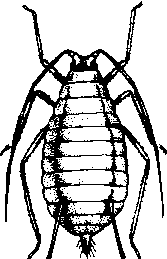月季长管蚜
Macrosiphum rosivorum Zhang,昆虫纲,同翅目,蚜科。分布于华东、华中地区。寄主有月季、蔷薇属植物。无翅孤雌蚜体长约4.2 mm,体淡绿色和黄绿色,少数橙红色;触角6节,比体长;腹管长圆筒形,前端呈网眼状;尾片长圆锥形,生有7~8根长毛,颜色同体色。有翅孤雌蚜头、胸灰褐色,腹部淡色。若蚜体比成蚜色浅,复眼红色。中国一年发生多代,以成、若蚜在寄主叶芽和叶背越冬。主害花蕾、嫩梢、嫩叶,全年有两次繁殖高峰期,分别在4月下中旬至5月份,9月下旬至10月上旬。宜保护瓢虫、草蛉等天敌,喷氧化乐果、抗蚜威等药剂进行防治。

月季长管蚜